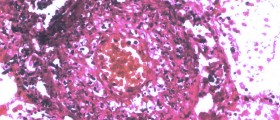Hepatic hemangioma is a benign growth in the liver made up of widened blood vessels. Hepatic hemangioma is a very common liver tumor. Women are usually more affected than men, but it may affect infants as well. The size of hepatic hemangioma is usually less than 1 cm in diameter. Small growth typically does not cause any symptoms and does not require treatment. However, hepatic hemangioma may reach more than 20 cm and it is usually followed by pain and other symptoms. Giant hepatic hemangioma is a term for tumors larger than 5 cm. Giant hemangiomas are more commonly seen in women.
Symptoms of Hepatic Hemangioma
Hepatic hemangioma is usually asymptomatic. Small hemangiomas never cause symptoms and are frequently accidentally discovered while doing tests for unrelated health problems. However, a large hepatic hemangioma can cause symptoms and interfere with the function of certain organs if the growth is positioned near it. Large hemangiomas are associated with nausea, pain in the abdomen, and enlargement of the liver.
In rare cases, large hemangiomas can rupture and cause severe pain and bleeding in the abdomen. This requires prompt management since it can have fatal outcomes. Infants with hepatic hemangioma may present symptoms such as anemia and the development of abdominal mass.

Causes of Hepatic Hemangioma
It is believed that hepatic hemangioma is a congenital defect. It can occur at any age but it is commonly diagnosed in people aged between 30 and 50. In infants, hepatic hemangioma (also called benign infantile hemangioendothelioma) can be a life-threatening condition. As already mentioned women are affected by hepatic hemangioma more often and usually have larger growths compared to men.
Hepatic Hemangioma Removal
After diagnosing the tumor with the help of CT and MRI scans, blood tests, and hepatic angiogram, a doctor can decide on adequate treatment. The most effective way to treat hepatic hemangioma is surgical removal of the growth. This can be done by different procedures. A surgeon may perform liver resection to remove a large tumor.
Another option for treating giant hepatic hemangioma is a liver transplant, but it is commonly recommended for those with multiple hemangiomas. Liver resection and liver transplant are indicated in case of rapid growth or spontaneous rupture of the tumor.
The condition can be also treated with procedures that decrease the size of large growths. One such procedure is the ligation of the liver artery, in which blood vessels that supply the liver with blood are tied off.
Embolization of the liver is another procedure for shrinking the tumor, which involves blocking the blood vessels connected to the liver. Blood vessels are blocked by injecting a substance (emboli). The procedure also provides pain relief.
- HH can develop in a broad range of age groups, but 60–80% of patients with HH are 30–50 years old; women were found to be more susceptible to HH than men, with a female-to-male ratio of 1.2–6:1.
- The rate of premature portal vein thrombosis in arterial phase images in HH patients using iodine contrast for hepatic arterial evaluation by digital subtraction angiography (DSA) was 73%. On the other hand premature portal vein thrombosis could be observed in almost 100% of hepatic arterial evaluations by medical CO2-DSA.
- HHs are mainly asymptomatic and require no treatment; although, follow-up is essential. However, multiple large HHs can present with symptoms such as abdominal pain, nausea, vomiting, and loss of appetite, indicating the necessity of treatment.
- The accuracy of ultrasound, CT, and MRI examinations for diagnosing HHs was reported to be as high as 61%, 77%, and 92%, respectively.
- Surgical and interventional therapies for HHs have the highest dominance; however, both have advantages and disadvantages. Although surgery is considered the most appropriate option for some HHs, treating multiple and/or massive HHs remains a major clinical challenge. Due to recent advances in minimally invasive interventional techniques, surgery is no longer the preferred treatment for multiple or extensive lesions. Interventional treatment, including transarterial embolization, ablation, percutaneous sclerotherapy, and percutaneous argon-helium cryotherapy, has gradually developed as an alternative approach to surgical resection for treating hepatic tumors.






-And-Children-16-Warning-Signs-And-Symptoms_f_280x120.jpg)









Your thoughts on this
Loading...